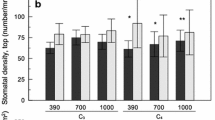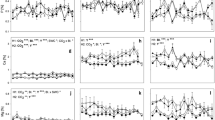Abstract
The effects of elevated CO2 on plant biomass and community structure have been studied for four seasons in a calcareous grassland in northwest Switzerland. This highly diverse, semi-natural plant community is dominated by the perennial grass Bromus erectus and is mown twice a year to maintain species composition. Plots of 1.3 m2 were exposed to ambient or elevated CO2 concentrations (n = 8) using a novel CO2 exposure technique, screen-aided CO2 control (SACC) starting in March 1994. In the 1st year of treatment, the annual harvested biomass (sum of aboveground biomass from mowings in June and October) was not significantly affected by elevated CO2. However, biomass increased significantly at elevated CO2 in the 2nd (+20%, P = 0.05), 3rd (+21%, P = 0.02) and 4th years (+29%, P = 0.02). There were no detectable differences in root biomass in the top 8 cm of soil between CO2 treatments on eight out of nine sampling dates. There were significant differences in CO2 responsiveness between functional groups (legumes, non-leguminous forbs, graminoids) in the 2nd (P = 0.07) and 3rd (P < 0.001) years of the study. The order of CO2 responsiveness among functional groups changed substantially from the 2nd to the 3rd year; for example, non-leguminous forbs had the smallest relative response in the 2nd year and the largest in the 3rd year. By the 3rd year of CO2 exposure, large species-specific differences in CO2 response had developed. For five important species or genera the order of responsiveness was Lotus corniculatus (+271%), Carex flacca (+249%), Bromus erectus (+33%), Sanguisorba minor (no significant CO2 effect), and six Trifolium species (a negative response that was not significant). The positive CO2 responses in Bromus and Carex were most closely related to increases in tiller number. Species richness was not affected by CO2 treatment, but species evenness increased under elevated CO2 (modified Hill ratio; P = 0.03) in June of the 3rd year, resulting in a marginally significant increase in species diversity (Simpson's index; P = 0.09). This and other experiments with calcareous grassland plants show that elevated atmospheric CO2 concentrations can substantially alter the structure of calcareous grassland communities and may increase plant community biomass.
Similar content being viewed by others
Author information
Authors and Affiliations
Additional information
Received: 12 July 1997 / Accepted: 14 September 1998
Rights and permissions
About this article
Cite this article
Leadley, P., Niklaus, P., Stocker, R. et al. A field study of the effects of elevated CO2 on plant biomass and community structure in a calcareous grassland. Oecologia 118, 39–49 (1999). https://doi.org/10.1007/s004420050701
Issue Date:
DOI: https://doi.org/10.1007/s004420050701




